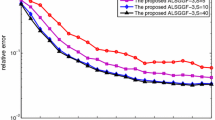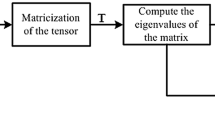Abstract
A new method to effectively reduce the complexity for underdetermined blind system identification with complex mixtures is proposed in this paper. Generally speaking, the identifiability of a MIMO system can be guaranteed by decomposing a tensor constructed by the cumulant of the observations in an appropriate order, but higher order statistics will bring heavier computation load as well as more estimation errors. In the proposed method, by stacking two order-K tensors with \(K-1\) identical factor matrices, a new tensor can be constructed followed by a PARAFAC decomposition, in which way the required minimum order of statistics can be reduced for a given underdetermined system. Experiments conducted on both the order-3 and order-4 tensors-stacking demonstrate the merits of the proposed algorithm in reducing the computational complexity while not degrading the identification performance in comparison with the standard alternating least squares algorithm. Specifically, in the \(4 \times 3\) and \(6 \times 3\) underdetermined systems, the numerical complexity can be reduced by more than \(50\%\) and \(90\% \), respectively. Furthermore, the proposed algorithm outperforms the classical blind source separation algorithms in the determined and overdetermined cases especially in low SNRs.













Similar content being viewed by others
References
A. Anandkumar, R. Ge, D. Hsu, S.M. Kakade, M. Telgarsky, Tensor decompositions for learning latent variable models. J. Mach. Learn. Res. 15, 2773–2832 (2014)
L. Albera, A. Ferrol, P. Comon, P. Chevalier, Sixth order blind identification of underdetermined mixtures (BIRTH) of sources, in 4th International Symposium on Independent Component Analysis and Blind Signal Separation (ICA2003) (2003), pp. 909–914
P. Comon, M. Rajih, Blind identification of under-determined mixtures based on the characteristic function. Signal Process. 86, 2271–2281 (2006)
P. Chevalier, L. Albera, A. Ferrol, P. Comon, On the virtual array concept for higher order array processing. IEEE Trans. Signal Process. 53, 1254–1271 (2005)
A. Cichocki, D.P. Mandic, A.H. Phan, C.F. Caiafa, G.-X. Zhou, Q.-B. Zhao, L.D. Lathauwer, Tensor decompositions for signal processing applications: from two-way to multiway component analysis. IEEE Signal Process. Mag. 32, 145–163 (2015)
J.F. Cardoso, A. Souloumiac, Blind beamforming for non Gaussian signals. IEE Proc. F-Radar Signal Process. 140, 362–370 (1993)
C.E.R. Fernandes, G. Favier, J.C.M. Mota, Blind channel identification algorithms based on the PARAFAC decomposition of cumulant tensors: the single and multiuser cases. Signal Process. 88, 1382–1401 (2008)
F.-L. Gu, H. Zhang, S. Wang, D.-S. Zhu, Blind identification of underdetermined mixtures with complex sources using the generalized generating function. Circuits Syst. Signal Process. 34, 681–693 (2015)
R.A. Harshman, Foundations of the PARAFAC procedure: Models and conditions for an explanatory multimodal factor analysis. UCLA Working Papers in Phonetics, vol. 16 (1970), pp. 1–84
Z. Koldovsky, P. Tichavsky, A.H. Phan, A. Cichocki, A two-stage MMSE beamformer for underdetermined signal separation. IEEE Signal Process. Lett. 20, 1227–1230 (2013)
A. Karfoul, L. Albera, G. Birot, Blind underdetermined mixture identification by joint canonical decomposition of HO cumulants. IEEE Trans. Signal Process. 58, 638–649 (2010)
T.G. Kolda, B.W. Bader, Tensor decompositions and applications. SIAM Rev. 51, 455–500 (2009)
L.D. Lathauwer, J. Castaing, Blind identification of underdetermined mixtures by simultaneous matrix diagonalization. IEEE Trans. Signal Process. 56, 1096–1105 (2008)
L.D. Lathauwer, J. Castaing, J.F. Cardoso, Fourth-order cumulant-based blind identification of underdetermined mixtures. IEEE Trans. Signal Process. 55, 2965–2973 (2007)
X. Luciani, A.D. Almeida, P. Comon, Blind identification of underdetermined mixtures based on the characteristic function: the complex case. IEEE Trans. Signal Process. 59, 540–553 (2001)
M. Novey, T. Adali, On extending the complex FastICA algorithm to noncircular sources. IEEE Trans. Signal Process. 56, 2148–2154 (2008)
A. Stegeman, N.D. Sidiropoulos, On Kruskals uniqueness condition for the Candecomp/Parafac decomposition. Linear Algebra Appl. 420, 540–552 (2007)
J. van de Laar, MIMO instantaneous blind identification and separation based on arbitrary order temporal structure in the data. Ph.D. thesis, Technische Universiteit Eindhoven (2007)
Y. Yu, A.P. Petropulu, PARAFAC-based blind estimation of possibly underdetermined convolutive MIMO systems. IEEE Trans. Signal Process. 56, 111–124 (2008)
Acknowledgements
The authors would like to thank the editors and reviewers for their careful reading and helpful remarks. This work is supported by the National Science Foundation of China under Grant 61671475.
Author information
Authors and Affiliations
Corresponding author
Rights and permissions
About this article
Cite this article
Yang, L., Zhang, H. & Cai, Y. A Low-Complexity PARAFAC Decomposition for Underdetermined Blind System Identification with Complex Mixtures. Circuits Syst Signal Process 37, 4842–4860 (2018). https://doi.org/10.1007/s00034-018-0787-7
Received:
Revised:
Accepted:
Published:
Issue Date:
DOI: https://doi.org/10.1007/s00034-018-0787-7




